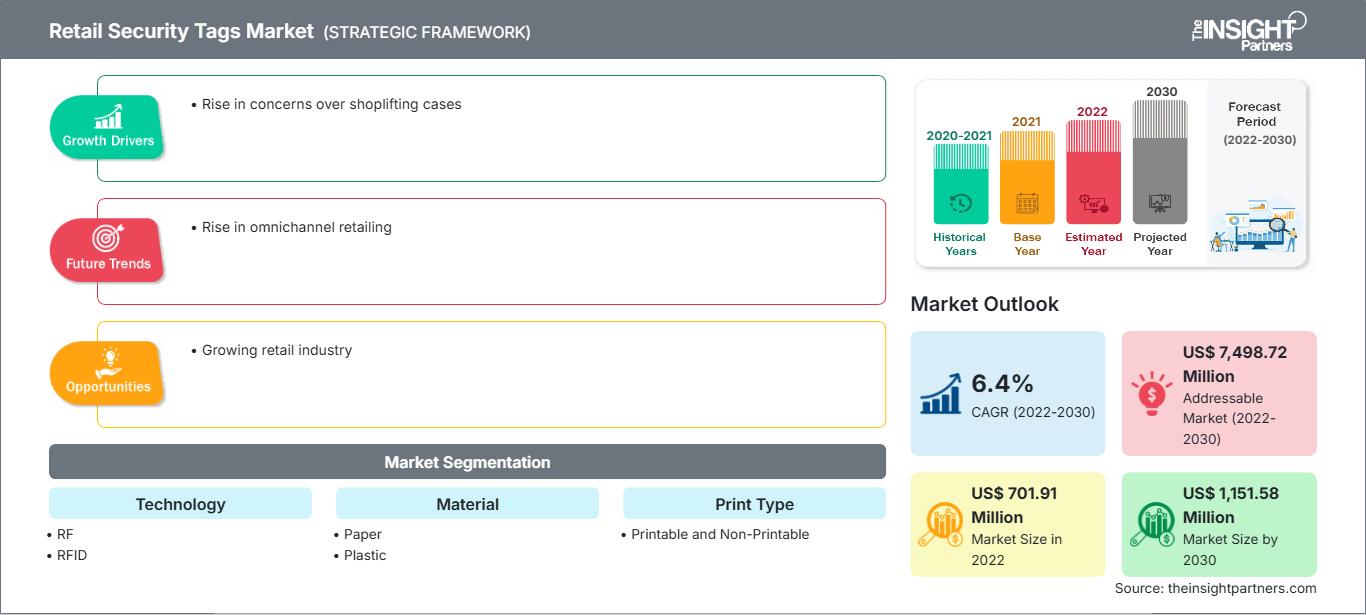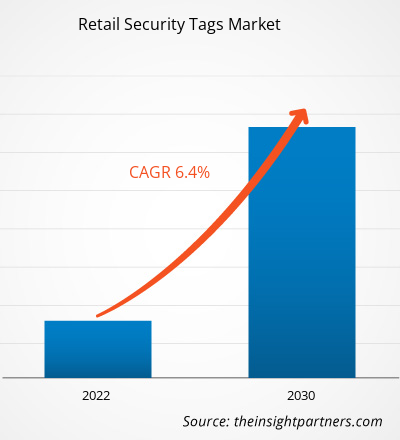预计到 2030 年,零售安全标签市场规模将从 2022 年的 7.0191 亿美元增至 11.5158 亿美元。预计该市场在 2022 年至 2030 年期间的复合年增长率为 5.60%。零售行业的数字化和零售店的不断涌现可能仍是市场的主要趋势。
零售安全标签市场分析
零售安全标签市场正受到新店开业、超市和大卖场兴起以及零售行业数字化程度提高等因素的推动。人们对零售盗窃的担忧日益加剧,促使零售店安装了先进的安全措施,从而推动了市场的增长。零售业的兴起、城市化进程的加快以及消费者可支配收入的增长是推动零售业发展的一些因素,这进一步推动了零售安全标签市场的发展。
零售安全标签市场概览
零售安全标签是零售商店安装的一种安全解决方案,用于防止盗窃和入店行窃。该安全解决方案还有助于提高供应链和库存管理的效率。7-Eleven、沃尔玛等全球零售品牌正致力于扩大其全球影响力,从而推动安全解决方案的采用。
自定义此报告以满足您的要求
您将免费获得任何报告的定制,包括本报告的部分内容,或国家级分析、Excel 数据包,以及为初创企业和大学提供超值优惠和折扣
零售安全标签市场: 战略洞察

-
获取本报告的主要市场趋势。这个免费样本将包括数据分析,从市场趋势到估计和预测。
零售安全标签市场驱动因素和机遇
对商店盗窃案件的担忧日益加剧
全球范围内的商店盗窃案件呈上升趋势。因此,全球品牌遭受了巨大的经济损失。因此,他们安装了先进的安全解决方案,以避免此类盗窃案件的发生。为了满足这种需求,各种市场参与者提供了高效的解决方案。例如,安全标签和EAS解决方案提供商Easitag为零售业提供RFID标签和芯片。它还提供EAS系统,可将盗窃率降低80%。这些系统可以提高利润并快速识别缺失库存,被认为是一种经济高效的解决方案。
零售业蓬勃发展
零售业包括一系列零售企业、大卖场/超市和专卖店,它们在全球范围内都在不断发展。此外,全球范围内新的超市和服装店也在不断增加。例如,2022 年 1 月,法国品牌 Gémo 宣布计划到 2025 年开设约 100 家门店。该公司提供各种鞋子、服装和配饰,零售安全标签用于库存管理以防止盗窃。因此,零售业的兴起,加上新超市和服装店的开业增加,推动了零售安全标签市场的发展。
零售安全标签市场报告细分分析
促成零售安全标签市场分析的关键细分领域包括技术、印刷类型、材料和应用。
- 根据技术,零售安全标签市场分为射频 (RF) 和 RFID。RFID 领域在 2022 年占据了最大的市场份额。
- 根据材料,零售安全标签市场分为纸质和塑料。 2022 年,塑料部分占据了相当大的市场份额。
- 根据材料,零售安全标签市场分为可打印和不可打印两类。2022 年,不可打印部分占据了相当大的市场份额。
- 根据应用,市场细分为服装和时尚配饰、化妆品和药品以及其他。2022 年,服装和时尚配饰部分占据了相当大的市场份额。
按地区划分的零售安全标签市场份额分析
零售安全标签市场报告的地理范围主要分为五个区域:北美、亚太地区、欧洲、中东和非洲以及南美和中美洲。
2023 年,欧洲地区占据了相当大的市场份额。欧洲零售业的不断发展是推动安全解决方案采用的主要因素。新超市建设的增加产生了对有助于管理库存的零售安全标签的需求。此外,2022年,欧洲各地为防止零售盗窃而开发的新产品有所增加。例如,2022年6月,零售安全解决方案制造商Century Europe推出了RFID多报警电缆标签T313-U9,该标签采用RFID技术追踪和识别产品,防止其被盗。此外,2022年10月,Century Europe推出了RFID+EAS多报警电缆标签T313,以提升其安全性和库存管理。这种双技术标签可重复用于不同的产品,有助于最大限度地减少商店盗窃案件。因此,用于管理产品库存和防止盗窃的新产品开发正在增加零售行业对零售安全标签的需求,从而推动欧洲零售安全标签市场的增长。
零售安全标签市场
零售安全标签市场
The Insight Partners 的分析师已详尽阐述了预测期内影响零售安全标签市场的区域趋势和因素。本节还讨论了北美、欧洲、亚太地区、中东和非洲以及南美和中美洲的零售安全标签市场细分和地域分布。
零售安全标签市场报告范围
| 报告属性 | 细节 |
|---|---|
| 市场规模 2022 | US$ 701.91 Million |
| 市场规模 2030 | US$ 1,151.58 Million |
| 全球复合年增长率 (2022 - 2030) | 6.4% |
| 历史数据 | 2020-2021 |
| 预测期 | 2022-2030 |
| 涵盖的领域 |
By 技术
|
| 覆盖地区和国家 |
北美
|
| 市场领导者和主要公司简介 |
|
零售安全标签市场参与者密度:了解其对业务动态的影响
零售安全标签市场正在快速增长,这得益于终端用户需求的不断增长,而这些需求的驱动因素包括消费者偏好的不断变化、技术进步以及对产品优势的认知度不断提高。随着需求的增长,企业正在扩展其产品线,不断创新以满足消费者需求,并利用新兴趋势,从而进一步推动市场增长。

- 获取 零售安全标签市场 主要参与者概述
零售安全标签市场新闻及最新发展
零售安全标签市场评估通过收集一手和二手研究后的定性和定量数据进行,这些数据包括重要的公司出版物、协会数据和数据库。零售安全标签市场的一些发展如下:
- rapitag GmbH 宣布推出其最新产品——智能防盗时尚标签。这款尖端时尚配饰是原版智能时尚标签的重新设计和升级版本,旨在提供更高的安全性和便利性。(来源:rapitag GmbH,新闻稿,2023 年 4 月)
- Century 是全球领先的创新型 EAS(电子商品监控)、RFID(射频识别)产品、系统和解决方案供应商,推出了一款完全集成的 RF+RFID 吊牌,以提高可视性和安全性。 CE353870 是一款创新的 RFID+EAS 双吊牌,它不仅能够最大限度地利用现有的 EAS 防损系统,还能通过一个吊牌优化 RFID 库存管理。这项双重用途的技术可以帮助零售商在实现防损的同时,提高商品的可见性,促进业务数字化,并带来降低人工成本和缩短处理时间的积极效果。(来源:Century,新闻稿,2024 年 1 月)
零售安全标签市场报告覆盖范围和交付成果
《零售安全标签市场规模及预测(2020-2030)》报告对市场进行了详细的分析,涵盖以下领域:
- 零售安全标签市场规模以及涵盖范围内所有关键细分市场的全球、区域和国家/地区预测
- 零售安全标签市场趋势以及市场动态,例如驱动因素、限制因素和关键机遇
- 详细的 PEST/Porter 五力模型和 SWOT 分析
- 零售安全标签市场分析,涵盖关键市场趋势、全球和区域框架、主要参与者、法规和最新市场发展
- 行业格局和竞争分析,涵盖市场集中度、热图分析、知名参与者和零售安全标签市场的最新发展
- 详细的公司简介
- 历史分析(2 年)、基准年、预测(7 年)及复合年增长率
- PEST和SWOT分析
- 市场规模、价值/数量 - 全球、区域、国家
- 行业和竞争格局
- Excel 数据集
近期报告
相关报告
客户评价
购买理由
- 明智的决策
- 了解市场动态
- 竞争分析
- 客户洞察
- 市场预测
- 风险规避
- 战略规划
- 投资论证
- 识别新兴市场
- 优化营销策略
- 提升运营效率
- 顺应监管趋势






















 获取免费样品 - 零售安全标签市场
获取免费样品 - 零售安全标签市场